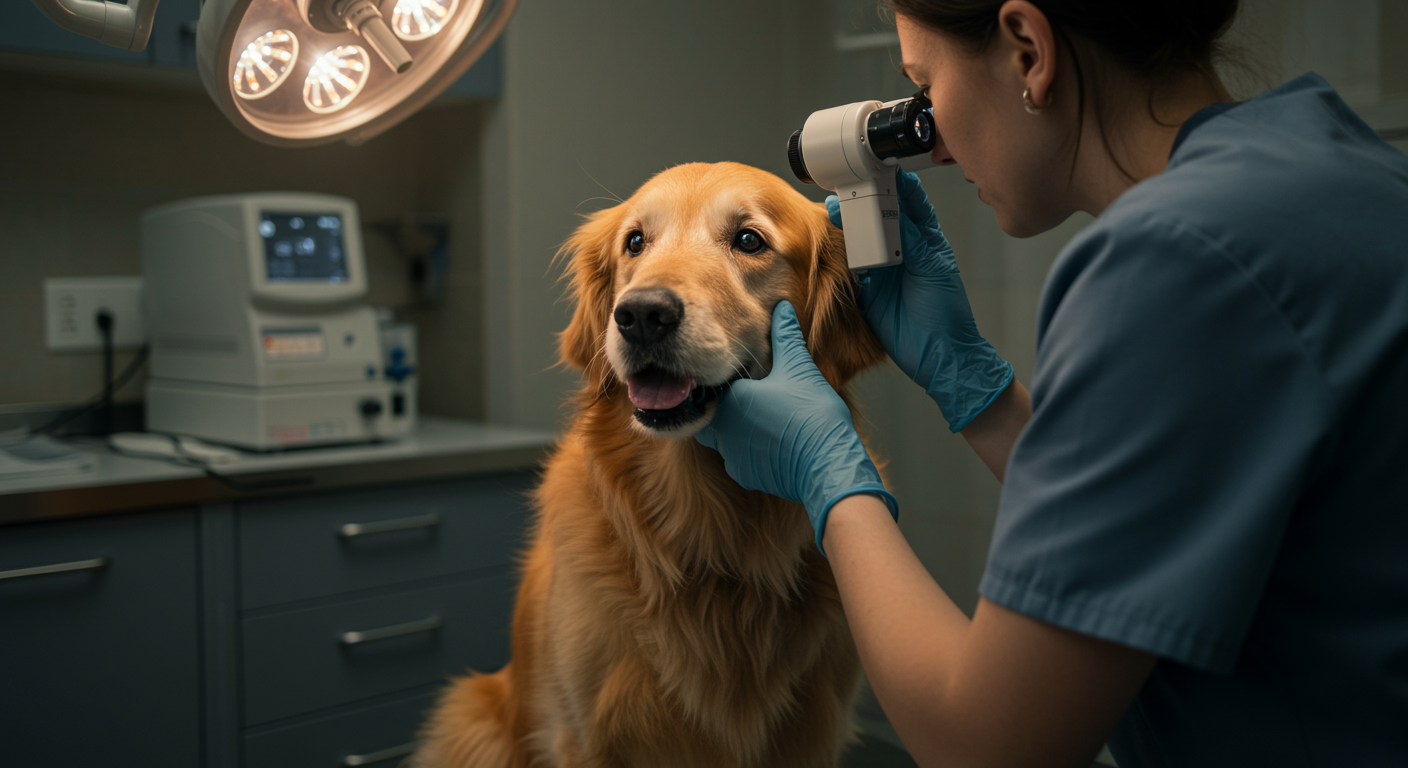Hearing loss represents one of the most common sensory changes affecting senior Golden Retrievers, with studies indicating that up to 65% of dogs over 10 years old experience some degree of hearing impairment. Unlike vision problems that often produce obvious behavioral changes, hearing loss in Golden Retrievers frequently develops gradually and may go unnoticed for extended periods due to dogs’ remarkable ability to compensate using their other senses. Understanding how to recognize, manage, and adapt to hearing loss becomes essential for maintaining quality of life and ensuring the safety of aging Golden Retrievers throughout their golden years.
The impact of hearing loss extends far beyond simple communication challenges. Dogs experiencing auditory impairment may become more anxious, show changes in sleep patterns, or develop behavioral modifications that owners mistakenly attribute to stubbornness or cognitive decline. However, with appropriate understanding, environmental adaptations, and communication modifications, dogs with hearing loss can continue to live fulfilling, joyful lives while maintaining strong bonds with their human families.
Golden Retrievers, with their intelligent and adaptable nature, often adjust remarkably well to hearing loss when provided with appropriate support and understanding. Their strong visual awareness, excellent scent capabilities, and deep bonds with their families provide solid foundations for successful adaptation to auditory changes. The key lies in recognizing hearing loss early, implementing appropriate management strategies, and maintaining patience and consistency while helping these beloved companions navigate their changing sensory world.
Understanding Canine Hearing Loss
Types and Causes of Hearing Loss
Hearing loss in senior Golden Retrievers can result from various causes, each requiring different approaches to management and adaptation.
Age-Related Hearing Loss (Presbycusis): The most common form of hearing loss in senior dogs, presbycusis involves gradual deterioration of the inner ear structures responsible for detecting and processing sound. This condition typically affects both ears symmetrically and progresses slowly over months or years.
Conductive Hearing Loss: Results from problems in the outer or middle ear that prevent sound waves from reaching the inner ear. Common causes include ear infections, wax buildup, foreign objects, or structural abnormalities. This type of hearing loss may be partially or completely reversible with appropriate treatment.
Sensorineural Hearing Loss: Involves damage to the inner ear or auditory nerve pathways and is typically permanent. Causes include genetic factors, ototoxic medications, loud noise exposure, or infections that damage delicate inner ear structures.
Mixed Hearing Loss: Combines elements of both conductive and sensorineural hearing loss, requiring comprehensive evaluation to determine the most appropriate management approach.
Degrees of Hearing Impairment
| Hearing Loss Severity | Characteristics | Behavioral Signs | Management Approach |
|---|---|---|---|
| Mild | Difficulty hearing quiet sounds | Occasionally unresponsive to soft calls | Speak louder, use visual cues |
| Moderate | Difficulty hearing normal conversation | Responds only to loud sounds | Combine verbal and visual signals |
| Severe | Can only hear very loud sounds | Limited response to environmental sounds | Primarily visual communication |
| Profound/Complete | Little to no hearing ability | No response to sound | Exclusively visual/tactile communication |
Risk Factors for Hearing Loss
Genetic Predisposition: While Golden Retrievers don’t have particularly high rates of hereditary deafness compared to some breeds, individual genetic factors can influence susceptibility to age-related hearing loss.
Chronic Ear Infections: Repeated ear infections throughout life can cause structural damage that contributes to hearing loss in senior years. Golden Retrievers’ floppy ears and love of water can predispose them to ear problems.
Medication Side Effects: Certain medications, including some antibiotics, diuretics, and chemotherapy drugs, can cause ototoxicity that damages hearing structures.
Environmental Factors: Long-term exposure to loud noises, though less common in pet dogs than working dogs, can contribute to hearing loss over time.
Underlying Health Conditions: Diabetes, thyroid disorders, and other systemic conditions can affect hearing through various mechanisms.
Recognizing Hearing Loss in Golden Retrievers
Early Warning Signs
Identifying hearing loss in its early stages allows for prompt veterinary evaluation and earlier implementation of adaptive strategies.
Subtle Response Changes: Dogs may begin responding more slowly to their name being called, require louder voices to get their attention, or seem to ignore commands they previously followed reliably.
Sleep Pattern Modifications: Dogs with hearing loss often sleep more soundly and may not wake to household noises that previously roused them, such as doorbells, telephones, or other dogs barking.
Increased Startle Response: Dogs who can’t hear approaching people or animals may show exaggerated startle responses when touched unexpectedly, particularly when sleeping or resting.
Vocal Changes: Some dogs with hearing loss become more vocal, barking more frequently or loudly because they cannot hear themselves or environmental sounds that would normally regulate their vocalizations.
Attention-Seeking Behaviors: Dogs may increase visual contact with their owners, staying closer or positioning themselves where they can see family members more easily.
Progressive Signs of Hearing Loss
Selective Responsiveness: Dogs may appear to respond to some sounds while ignoring others, often leading owners to believe the dog is being stubborn rather than experiencing hearing difficulties.
Environmental Awareness Changes: Dogs may show decreased awareness of environmental sounds such as cars approaching, other dogs barking, or household activities they previously monitored closely.
Training Regression: Previously reliable responses to verbal commands may become inconsistent, leading to apparent “disobedience” that’s actually related to hearing impairment.
Social Behavior Modifications: Dogs may become less interactive with family members or show changes in their response to visitors, often becoming more cautious or withdrawn.
Distinguishing Hearing Loss from Other Conditions
Cognitive Dysfunction vs. Hearing Loss: Both conditions can cause apparent disobedience or confusion, making differential diagnosis important. Dogs with cognitive dysfunction typically show multiple behavioral changes beyond hearing-related issues.
Selective Attention vs. Hearing Loss: Some dogs learn to ignore certain commands or sounds, while others genuinely cannot hear them. Professional evaluation can help distinguish between behavioral and medical causes.
Pain-Related Avoidance: Dogs experiencing pain may avoid responding to commands that require movement, which can be mistaken for hearing loss. Comprehensive health evaluation helps identify multiple contributing factors.
| Behavior | Hearing Loss | Cognitive Dysfunction | Selective Attention |
|---|---|---|---|
| Response to favorite sounds | No response to any volume | Delayed or confused response | Immediate response |
| Consistency | Consistently poor hearing | Variable daily performance | Context-dependent response |
| Other symptoms | Primarily auditory changes | Multiple behavioral changes | Normal behavior otherwise |
| Response to visual cues | Excellent visual response | May have visual processing issues | Good when motivated |
Professional Evaluation and Diagnosis
Veterinary Assessment
Physical Examination: Comprehensive ear examination using otoscopy to visualize the ear canal and eardrum, checking for infections, blockages, or structural abnormalities that might contribute to hearing loss.
Hearing Tests: Basic hearing assessment through behavioral response testing, including response to various sound frequencies and volumes in controlled conditions.
Neurological Evaluation: Assessment of overall neurological function to rule out central nervous system causes of apparent hearing loss.
Medical History Review: Detailed discussion of onset, progression, and associated symptoms helps identify potential causes and guide treatment planning.
Advanced Diagnostic Testing
BAER Testing (Brainstem Auditory Evoked Response): The gold standard for objective hearing assessment in dogs, BAER testing measures electrical responses in the auditory pathway and can detect hearing loss before behavioral signs become apparent.
Tympanometry: Evaluates middle ear function by measuring eardrum movement in response to pressure changes, helping identify conductive hearing loss causes.
CT or MRI Imaging: Advanced imaging may be recommended for dogs with suspected structural abnormalities, tumors, or other complex causes of hearing loss.
Laboratory Testing: Blood work may be indicated to rule out systemic conditions that could contribute to hearing problems, such as hypothyroidism or diabetes.
Treatment of Reversible Causes
Ear Cleaning and Medication: Thorough ear cleaning and appropriate medications can resolve hearing loss caused by infections, inflammation, or wax accumulation.
Foreign Object Removal: Professional removal of foreign materials from ear canals can restore hearing when obstruction is the primary cause.
Medical Management: Treatment of underlying conditions such as hypothyroidism or diabetes may help prevent further hearing loss progression.
Medication Adjustments: Discontinuing or changing ototoxic medications may prevent additional hearing damage when alternative treatments are available.
Communication Adaptations and Training
Visual Communication Systems
Developing effective visual communication becomes essential for maintaining strong relationships with hearing-impaired Golden Retrievers.
Hand Signal Development: Establishing clear, consistent hand signals for basic commands helps maintain communication and training relationships. Start with simple, distinctive gestures that are easy to see and remember.
Facial Expression Utilization: Dogs are excellent at reading human facial expressions, making exaggerated happy faces, concerned expressions, or disapproving looks valuable communication tools.
Body Language Enhancement: Using whole-body movements and postures can help communicate intentions and emotions more effectively than subtle gestures alone.
Environmental Cues: Strategic use of visual environmental cues such as lights, flags, or positioning can help communicate routine changes or important information.
Training Modifications
Visual Command Training: Systematically teaching hand signals for existing verbal commands helps maintain training relationships while accommodating hearing loss.
| Verbal Command | Hand Signal | Training Tips | Reinforcement Strategy |
|---|---|---|---|
| Sit | Raised palm facing dog | Start with dog already knowing verbal cue | Pair with treat and praise |
| Stay | Open palm extended toward dog | Use from short distances initially | Gradually increase distance |
| Come | Sweeping arm gesture toward body | Practice in secure, enclosed areas | High-value treats and enthusiasm |
| Down | Palm pressed downward | Use lure-and-reward method | Be patient with learning curve |
| Good dog | Thumbs up or clapping | Use for positive reinforcement | Combine with treats and petting |
Attention-Getting Techniques: Teaching dogs to look for visual cues requires first getting their attention through gentle touching, movement within their visual field, or environmental cues like flashing lights.
Positive Reinforcement Emphasis: Hearing-impaired dogs benefit especially from clear, immediate positive reinforcement through treats, petting, and enthusiastic body language that communicates approval.
Patience and Consistency: Training modifications require extra patience as dogs learn new communication methods while adjusting to their changing sensory capabilities.
Safety Considerations and Environmental Management
Home Safety Modifications
Visual Alert Systems: Installing visual alert systems such as flashing lights connected to doorbells or phone rings helps hearing-impaired dogs stay aware of household activities.
Secure Fencing: Ensuring yard boundaries are secure becomes even more important for dogs who cannot hear approaching dangers or calls to return.
Consistent Routines: Maintaining predictable daily routines helps hearing-impaired dogs feel secure and reduces anxiety associated with unexpected changes.
Safe Spaces: Providing quiet, secure areas where dogs can rest without being startled by unexpected contact becomes especially important for hearing-impaired seniors.
Outdoor Safety Protocols
Leash Requirements: Dogs with hearing loss should be kept on leash in all but the most secure environments, as they cannot hear approaching vehicles, other animals, or emergency calls.
Identification Updates: Ensure identification tags and microchip information indicate hearing impairment so that anyone finding a lost dog understands their special needs.
Supervised Outdoor Time: Even in fenced yards, supervision becomes more important for hearing-impaired dogs who may not detect approaching dangers.
Reflective Gear: Using reflective collars, leashes, or clothing helps ensure visibility during low-light conditions when visual communication is most challenging.
Social Situation Management
Visitor Preparation: Educating visitors about appropriate interaction with hearing-impaired dogs helps prevent startling and ensures positive social experiences.
Other Pet Considerations: Managing interactions with other household pets may require modifications to prevent conflicts that the hearing-impaired dog cannot detect approaching.
Public Outings: When taking hearing-impaired dogs to public spaces, extra vigilance is required to monitor for potential dangers they cannot hear.
| Safety Area | Primary Concerns | Preventive Measures | Emergency Protocols |
|---|---|---|---|
| Home Environment | Startling, missed alerts | Visual alert systems, consistent routines | Emergency contact protocols |
| Yard/Garden | Escape, predator encounters | Secure fencing, supervision | Visual recall methods |
| Public Spaces | Traffic, other animals | Leash control, awareness | Quick visual redirection |
| Social Situations | Overwhelming stimuli, conflicts | Gradual introduction, supervision | Safe space availability |
Technology and Assistive Devices
Vibration-Based Communication
Vibrating Collars: Special collars that provide gentle vibration cues can be used to get a dog’s attention or communicate basic messages when visual contact isn’t possible.
Training with Vibration: Dogs can learn to associate different vibration patterns with specific meanings, though this requires patient training and should never be used punitively.
Remote Vibration Devices: Handheld devices that trigger collar vibrations can help communicate with dogs at distances where visual signals might not be effective.
Environmental Technology
Smart Home Integration: Home automation systems can be programmed to provide visual alerts for various household events, helping hearing-impaired dogs stay connected to family activities.
Monitoring Systems: Video monitoring can help owners keep track of hearing-impaired dogs when they cannot rely on auditory cues to monitor their pets’ activities.
Lighting Systems: Programmable lighting systems can provide environmental cues for routine activities such as meal times, walks, or bedtime.
Communication Apps and Tools
Visual Communication Boards: Some owners find success with simple visual communication boards that use pictures or symbols to represent common activities or needs.
Training Apps: Smartphone applications designed for dog training can provide visual cues and timing tools that support consistent communication approaches.
Record Keeping: Digital tools for tracking behavioral changes, training progress, and health status help monitor adaptation to hearing loss over time.
Managing Behavioral Changes
Anxiety and Stress Reduction
Predictability Enhancement: Maintaining consistent routines and environments helps reduce anxiety that can develop when dogs cannot hear environmental cues that previously provided security.
Confidence Building: Positive training experiences and successful communication interactions help maintain confidence and prevent withdrawal or fearfulness.
Stress Signal Recognition: Learning to recognize visual stress signals becomes important when dogs cannot use vocalizations as effectively to communicate discomfort.
Calming Techniques: Visual and tactile calming techniques such as gentle massage, predictable handling, and secure resting areas support emotional well-being.
Social Behavior Support
Family Member Education: All household members need to learn appropriate interaction techniques to ensure consistent, positive experiences for hearing-impaired dogs.
Visitor Management: Preparing visitors for appropriate interaction helps prevent negative experiences that could increase anxiety or defensive behaviors.
Other Pet Integration: Managing relationships with other household pets may require modifications to communication and interaction patterns.
Professional Guidance: Working with professional dog trainers experienced in sensory impairments can provide valuable guidance for managing behavioral challenges.
Quality of Life Considerations
Maintaining Engagement
Sensory Enrichment: Emphasizing enrichment through scent, touch, and visual stimulation helps maintain mental engagement when auditory input is reduced.
Activity Modifications: Adapting favorite activities to rely more on visual and scent cues rather than auditory signals helps maintain enjoyment and engagement.
Social Connection: Maintaining strong social connections through appropriate interaction modifications supports emotional well-being and prevents isolation.
Mental Stimulation: Puzzle toys, scent work, and visual training exercises provide mental stimulation that doesn’t rely on hearing ability.
Long-Term Adaptation
Progressive Adjustments: As hearing loss may continue to progress, ongoing adaptations to communication and management approaches may be necessary.
Health Monitoring: Regular veterinary check-ups help monitor for additional age-related changes that might affect adaptation to hearing loss.
Family Support: Ensuring all family members remain committed to appropriate communication methods supports long-term success and relationship quality.
Professional Resources: Maintaining relationships with veterinary professionals and experienced trainers provides ongoing support for managing challenges as they arise.
| Quality of Life Factor | Maintenance Strategies | Warning Signs | Intervention Approaches |
|---|---|---|---|
| Mental Engagement | Varied activities, training | Lethargy, disinterest | Increase stimulation variety |
| Social Connection | Regular interaction, consistency | Withdrawal, avoidance | Gentle re-engagement techniques |
| Physical Activity | Adapted exercise routines | Reduced activity, weight gain | Modified exercise programs |
| Emotional Well-being | Predictability, positive experiences | Anxiety, depression signs | Professional behavioral support |
Supporting Families Through Hearing Loss
Owner Education and Support
Understanding Normal Adaptation: Helping owners understand that most dogs adapt well to hearing loss with appropriate support reduces anxiety and promotes positive approaches.
Realistic Expectations: Setting appropriate expectations for adaptation timelines and outcomes helps prevent frustration and supports consistent implementation of management strategies.
Communication Training: Teaching family members effective visual and tactile communication techniques ensures consistent, positive interactions.
Problem-Solving Skills: Providing owners with problem-solving frameworks helps them address new challenges that may arise as dogs adapt to hearing loss.
Community Resources
Support Groups: Connecting with other owners of hearing-impaired dogs can provide practical advice, emotional support, and innovative management ideas.
Professional Training: Working with trainers experienced in sensory impairments provides specialized expertise for addressing unique challenges.
Veterinary Specialists: Relationships with veterinary neurologists or behavior specialists can provide additional support for complex cases.
Online Resources: Accessing reputable online resources and communities provides ongoing education and support for managing hearing-impaired dogs.
Embracing Silent Communication
Dealing with hearing loss in senior Golden Retrievers requires patience, creativity, and understanding, but it need not diminish the deep bond between these remarkable dogs and their human families. The transition from auditory to visual communication often reveals new dimensions of the human-canine relationship, emphasizing the profound connection that exists beyond words and sounds.
Many owners discover that their relationship with their hearing-impaired Golden Retriever becomes even deeper as they develop new ways of communicating and connecting. The increased reliance on visual cues, body language, and physical presence often strengthens the emotional bond while demonstrating the remarkable adaptability of both dogs and their devoted families.
Success in managing hearing loss lies not in mourning the loss of auditory communication but in embracing the opportunities for enhanced visual and emotional connection. Dogs with hearing loss often become more visually attentive to their owners, more responsive to subtle body language cues, and more appreciative of physical presence and gentle touch.
Your commitment to supporting your Golden Retriever through hearing loss demonstrates the depth of your love and understanding of their changing needs. Through patient adaptation of communication methods, thoughtful environmental modifications, and consistent positive reinforcement, you ensure that hearing loss becomes simply another chapter in your shared journey rather than a barrier to continued joy and companionship. The silence that hearing loss brings can become filled with the rich, wordless communication that defines the special bond between Golden Retrievers and the families who love them unconditionally.

Rafael Souza is a digital marketing strategist and lifelong dog enthusiast. Passionate about Golden Retrievers, he shares practical, research-based tips to help owners provide healthier and happier lives for their furry companions.






1 thought on “How to Deal with Hearing Loss in Senior Golden Retrievers”